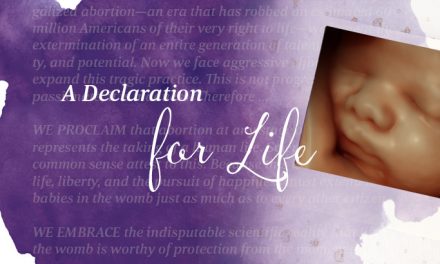The American College of Obstetricians and Gynecologists released the “ACOG Guide to Language and Abortion” this month. The guide tells OB-GYNs not to use the words “baby” or “unborn child” when talking to a woman about her pregnancy.
ACOG argues, “Centering the language on a future state of a pregnancy is medically inaccurate. As long as the pregnancy continues, the language should reflect the current state.” OB-GYNs are told, “Use instead: Through 8 weeks after last menstrual period, ‘embryo.’ After that point until delivery, ‘fetus.’”
To be most clear and accurate, ACOG might want to have health care practitioners say, “human embryo” or “human fetus.” But that might be too much of a reminder of the humanity of the unborn child developing inside the womb.
And certainly don’t say “womb,” as I just did, because it’s a “a non-medical term that can be used to apply an emotional value to a human organ.”
Dr. Jennifer Roback Morse, president of the Ruth Institute, commented on the guidance in a press release, “This is absurd and not how people talk, including medical professionals. If a woman visits her OB-GYN, the physician doesn’t ask, ‘So, how’s the fetus doing?’”
OB-GYNs are also told not to say, “heartbeat bill” or “fetal heartbeat,” because “there are no chambers of the heart developed at the early stage in pregnancy that this word is used to describe, so there is no recognizable ‘heartbeat.’”
So because the heart isn’t fully developed, you mustn’t call it a heart. The guide doesn’t give a replacement for the word “heart,” but it uses “fetal cardiac activity” for the not-fully-developed-heart’s actions in pumping blood through a preborn baby’s not-fully-developed body. (Are we allowed to use the term “body,” since the “body” is still growing and developing in utero? The guide doesn’t say.)
As far as terms for abortion, the guidelines suggest avoiding terms like “dismemberment ban” – because using this term “is intentional use of inflammatory, emotional language and centers the procedure on the fetus, rather than on the pregnant person who is the clinician’s patient” – even though the fetus is the one being dismembered.
“Pregnant person,” of course is a nod to the so-called “transgender and non-binary” community. According to ACOG, persons get pregnant, not women. The language guidance completely avoids terms like “woman” or “mother.”
Other terms for ending the life in a womb are sanitized. “Chemical abortion” “is a biased term designed to make medication abortion sound scarier than the safe, effective medical intervention it is,” so it becomes “medication abortion.”
“Surgical abortion” is an “abortion procedure.” And “elective abortion” should never be used because, “The motivation behind the decision to get an abortion should not be judged as ‘elective’ or ‘not elective’ by an external party.”
“Late-term abortion” is also forbidden. It should be replaced with “abortion later in pregnancy.”
Morse said, “The forces of the Sexual Revolution get more disingenuous by the day. Now they’re trying to sanitize the language of the abortion debate to hide reality.”
ACOG admits its motives in the introduction to the guide when it says, “Much of the language that is colloquially used to describe abortion or discuss health policies that impact abortion has a basis in anti-choice rhetoric and is inherently biased and inaccurate – and at the very least, is not medically appropriate [author’s emphasis].”
Got that? Colloquial language, such as “baby,” “infant” or “unborn child” – any words that would make someone think of a human life – is “inherently biased and inaccurate.”
In a final summation of the ACOG Guide, Morse stated, “Proponents of the Sexual Revolution, including the American College of Obstetricians and Gynecologists, are growing desperate. Opinion polls show public opinion shifting against them, hence the absurd attempt to adopt language that cloaks reality.”
Related articles and resources:
Abortion Facts, Stats and Research
Abortion’s Impact on the Black Community
Alternatives to Abortion: Pregnancy Resource Centers
Focus on the Family Pro-Life Resources
Focus on the Family Broadcast: Finding Healing and Hope After an Abortion, Part 1 and Part 2
Post-Abortive Recovery Resources
Pro-Life Arguments Explained, Part 1 and Part 2
Photo from Shutterstock.






